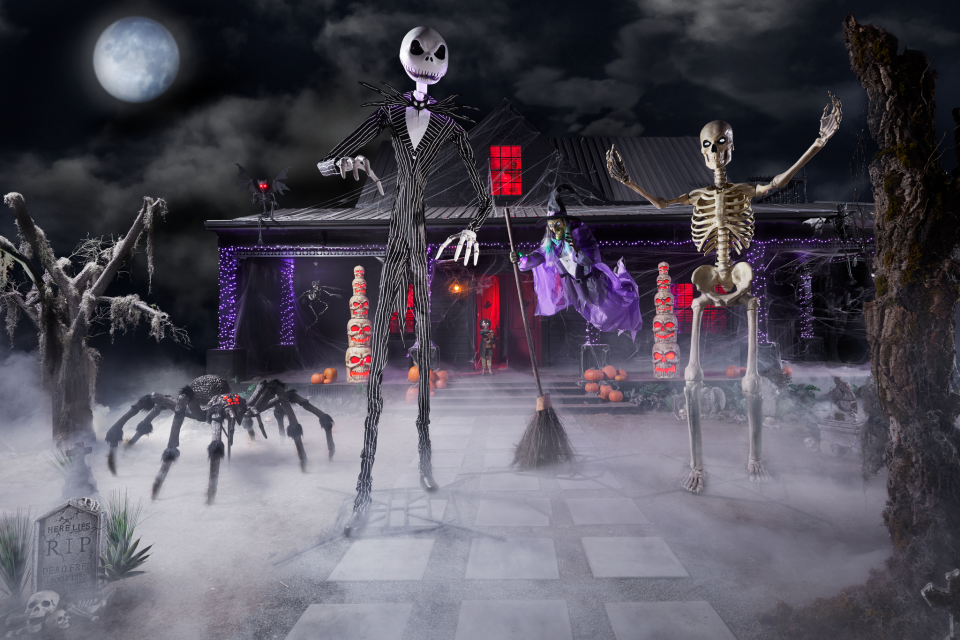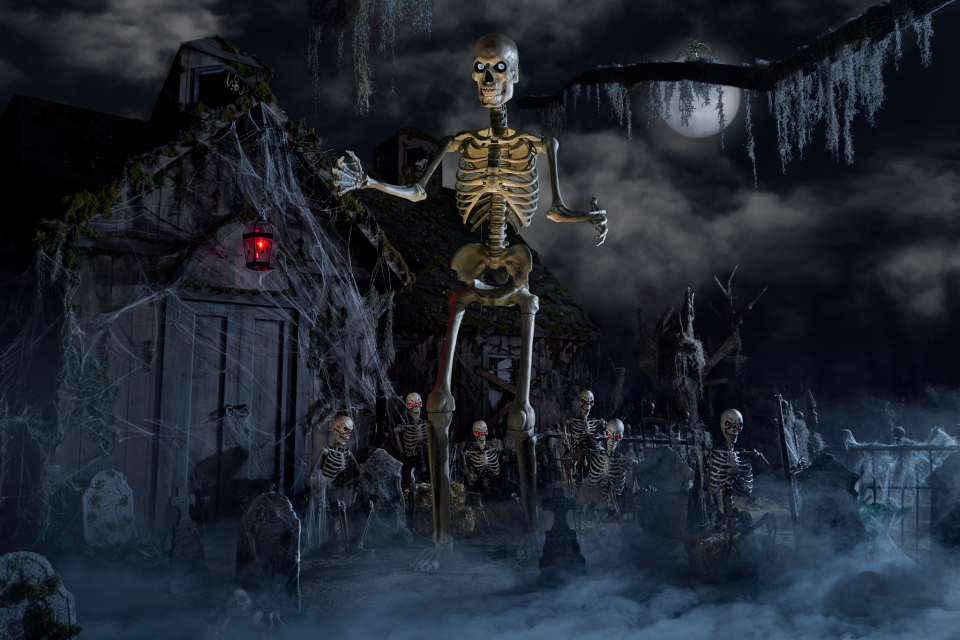Think Halloween is coming earlier every year? You're not imagining things
It’s a hot summer day. You head to the store to grab a few items; maybe groceries, maybe a few things you need for that home project. You walk through the doors into the much-needed air conditioning and then you spot it: a jack-o-lantern staring at you atop an orange and black display dotted with fun-sized candy and grinning skulls.
If your first thought is “Halloween already!? It comes earlier every year!” you are certainly not the first. While many stores hold off on fully stocking for the spooky holiday until at least late August or early September, it’s not exactly unusual to see displays popping up as early as the first or second week of July.
Walk into a Michaels Store any time after July 7th this year and you’ll find the Halloween season in full swing, for example. Others roll out Halloween merchandise online well before ushering it into stores, such as Home Goods, which launched an entire tab dedicated to Halloween on its website last month.
The onslaught of witches, ghosts and ghouls while the weather still scorches outside feels premature to some, but has Halloween always been this way? Is it the new Christmas, ever-expanding its hold on an entire season, and is it really coming to stores sooner every year?
Move over, 12ft skeleton, Lewis is here: 'I am Lewis': Target's Halloween jack-o'-latern decoration goes viral on TikTok
The “holiday season” has expanded
According to Joel Davis, Executive Director of the David F. Miller Retail Center of University of Florida’s Warrington College of Business, shopping for holidays like Christmas used to be a pretty last-minute ordeal.
“In the early 1900s, Christmas shopping was basically done a few days before Christmas. The whole family would gear up to go to that retail area and they’d shop for Christmas presents and then they would go home,” he told USA TODAY. That began to change over time, he said, especially leading into World War I.
“There was a push to actually have people do the shopping earlier to relieve the burden on the supply chain elsewhere,” Davis said. “I think it just continued since then.”
Retailers make up to 30% of their annual sales during the holiday season now, said Davis, meaning they want to expand the timeframe for buying in order to bolster product. Thanksgiving is a barrier to the start of that season, said Davis, and offers fewer opportunities for the sale of things like décor. That’s where Halloween comes in.
“I think retailers are looking for those [opportunities] and they're trying to drive, trying to create that holiday. That demand, if you want to call it that, because they need something other than Christmas,” he said. “They want to be able to spread their sales out through more of the year.”
He noted that while the “holiday season” used to be just November and December, it has definitely expanded to include October as well.
“The number one thing that they’re looking for is sales, obviously. They wouldn't do it if they didn't think it was profitable.”
Most popular candy be state: From Candy Corn to Kit Kats: The most popular (and hated) Halloween candy by state
Who decides when Halloween hits the shelves?
But who decides when exactly Halloween décor starts hitting shelves? And how are those decisions made? Well, like most things, it depends.
“Now retailers can use AI-driven programs to plan their assortments,” said Donna Smith, professor and Director of Retail Management at Ted Rogers School of Management of Toronto Metropolitan University. “Retailers often project based on historical figures and various internet searches and industry trends and reports. AI is replacing this in my opinion. Holidays such as Halloween are huge revenue generators for retailers”
Retailers also respond directly to customer requests, turn out at stores and the availability of products. According to Lance Allen, Senior Product Merchant of Decorative Holiday at Home Depot, it’s all about hitting the sweet spot between meeting demand and providing the best customer experience.
Home Depot launched its Halloween products online on July 13 this year, though the items won’t be available in stores until right before Labor Day. But even that isn’t soon enough for some.
“It's amazing what you see on some of the forums. People staying up all night knowing the website's going to launch. I mean, we had items that really kind of sold out the morning of the launch,” he said. “We find customers going into stores and asking stores to take product out of the overheads and bring it down to the floor before they even have time to set the stores.”
There are a lot of things to take into account when launching a product line, said Allen, such as supply chain flow, building up proper stock and time to get product photos and descriptions together. The fervor for these products to arrive in stores sooner, however, has increased since the COVID-19 pandemic, said Allen.
“Before [the pandemic], people normally just kind of decorated the last two weeks of October,” he said. “Where we see the skeleton and some of the other giant pieces we do year-round now. Or now people start decorating end of September. So, it's really, the season's gotten a lot longer now.”

The post-pandemic penchants for early Halloween
A similar trend has been observed by other retailers, such as Michaels Stores, which began setting out Halloween merchandise on July 7th – which was still not early enough for some enthusiasts, according to John Gehre, Chief Merchandising Officer.
“In 2021, Halloween product began setting in-stores in August. In the years since, consumer demand and trend has led us to start setting earlier,” said Gehre. “In 2022, we moved our assortment up by two weeks to set in late July, and this year we dropped the first of our private brand décor collections a week earlier than last year. “
Gehre said Michaels primarily looks towards consumer trends and historical demand to determine when and how to prepare for a holiday.
“Analyzing the previous year's early demand data helps us determine opportunities for an earlier rollout,” he said. “For example, last year we delivered our first Halloween décor items the last week of July and saw that there was customer demand right off the bat, which informed us to launch earlier this year.”
Halloween spending balloons: Costumes, candy, decor fuel $12.2 billion Halloween spending splurge in US: A new record
Data compiled by Granularity, a trend forecasting service that uses AI to predict future demand, supports the theory that the expansion of the Halloween season isn’t simply a hunch.
Sales of Halloween-related items on Amazon have been moving earlier and earlier. Excluding data from 2020, which was skewed due to COVID-19:
2019 saw a peak in Halloween item sales during the last week of September.
In 2021 and 2022, the peak started two weeks earlier than each year prior.
The data for 2023 shows that, so far, sales appear to be one week ahead of 2022.
The data also found that specific searches, such as those for “Halloween window displays,” have also seen an uptick earlier in the season over the past few years.
2022 August had 12.5% of yearly searches
2022 September had 5.1% of yearly searches
2021 August had 7.5% of yearly searches
2021 September had 4.0% of yearly searches
To shop or not to shop
So, is Halloween really coming earlier each year? Well, for some, yes, at least since 2020.
“It really seemed like COVID was the big change right there where people were looking for something to do,” said Lance Allen. “Or, ‘all right, I'm stuck at home. I'm not going to the office. What can I do safely that everybody can enjoy?’ So, they came out of 2020 … and it's really just kind of held course and stuck since then.”
Joel Davis agreed, point toward shifting shopping attitudes in the post-pandemic world.
“I think COVID and the supply chain shocks of 2020 probably accelerated this a little bit because of this fear of missing out again,” said Davis. “Am I going to be able to buy the Christmas products? I have children and I remember that Christmas wondering ‘how early do I need to buy in order to get the presents that they want?’”
This lingering attitude applies to other tentpole events throughout the year, including Halloween, Davis said. And, besides consumer behaviors that are a relic of 2020, he also believes people have come to enjoy using Halloween as another excuse to get together and celebrate with family and friends. That said, he thinks at least part of “Halloween keeps coming earlier” refrain all boils down to perception.
“I recall my parents saying, ‘Christmas is getting earlier every year,’ too. If that was true, then Christmas would already be in March,” he said. “I think most of this is perception and feelings, like we feel like it shouldn't be that early. And so, every year, we feel like it's much earlier than the year before.”
Will this compulsion for holiday preparation months in advance fade the further we get from 2020? That remains to be seen. For now, Halloween enthusiasts can enjoy the “new” holiday season and detractors can at least take comfort in that fact that no, it’s not just them. Halloween is coming earlier.

This article originally appeared on USA TODAY: Why Halloween stuff is out at Michaels, Home Depot earlier each year
